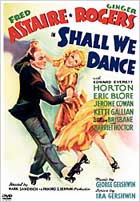
BUY IT AT
AMAZON: CLICK HERE!
STUDIO: RKO Radio Pictures, Inc.
MSRP: $14.98
RATED:
NR
RUNNING TIME: 109 Minutes
SPECIAL FEATURES:
• Audio Commentary by Songwriter Hugh Martin and Pianist Kevin Cole
• New Featurette: The Music of Shall We Dance
• Music Short: Sheik to Sheik
• Classic Cartoon: Toy Town Hall
Musicals in today’s day and age are almost dead. While Moulin Rouge revived talk of the second (or third or forth) coming of the genre known for having people be incredibly gay and merry, I don’t recall anything coming out since then that has struck mine, or anyone’s fancy. Unless you count You Got Served. I didn’t. Today you’d most likely be assaulted visually (and verbally, depending on who wrote it) and then lathered into a frothing mixture of hatred, annoyance and the hippest tracks that last all of fifteen seconds in nostalgia land.
So flash back with me, to a simpler time. Way back, millions of years before you were even a tiny swimmer in your Father’s package, all the way to the Depression. Musicals were the height of entertainment. Simply because they provided a natural escape into the elegant lives of people you’d not normally come in contact with, unless you were filthy rich. Like nowadays most of us aren’t, and so it’s natural to want to be entertained for a small price in order to survive the hardships of life.

When meeting with Kobe Tai, it’s best to dress up.
Back then there were two major stars, Fred Astaire, that guy you most likely know as the dude dancing with the vacuum on TV (sigh), and Ginger Rogers, a lady you’ll probably recognize from … nothing. Either way, they allowed respective audiences to forget their cares and be transported into the singing and dancing worlds of one of their many films together. Today they ask, some 68 odd years later: Shall We Dance?
The Flick
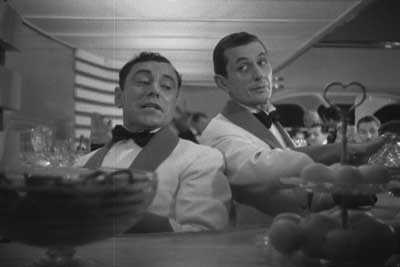
"Seriously, what the fuck is wrong with California?"
"Quit your whining!"
Fred Astaire is Peter P. Peters, alias Petrov, assuredly the greatest ballerina (or if you’re English – balley) dancer Paris has ever seen since Napoleon shunned Russia. He’s entirely unhappy with the direction of his career. He’s a jazzman see, and he wants to riff on some mighty good dancing moves in order to please himself. He has a desire to tap dance until the break of dawn. He’s definitely not planning to leave until six in the ‘morn, if you catch that drift. I’m not sure if he’s got a pocket full of rubbers, though. Unfortunately for him, his boss, Jeffrey Baird (played by the great comic foil Edward Everett Horton) has plans to introduce Petrov to America, and that avenue doesn’t involve infusing très modern tap dancing into the classical style of ballet. That sort of blasphemy is only good when there are floosies about.
Petrov’s got a wandering eye, and one of the first things he notices is the newest sensation Linda Keene (the gorgeous Rogers). Keene’s disillusioned with the whole Paris scene, and to make matters worse, now Astaire with his overtly faux Russian accent is on the hunt for some Keene meat. Completely and utter unimpressed, she slides off his back like water on oil, culminating in a scene entirely awkward, yet deliciously entertaining. Keene quickly high tails it out of Paris on the flagship The Queen Anne with the express purpose of returning to NYC and marrying one of her oldest sweethearts.

"Ah yes, we are laughing!"
"Indeed, we are having fun!"
As fortune would just so have it, Astaire tells a little white lie to the dastardly cunning plot device known as Lady Denise Tarkington on his way to NYC via, what else, The Queen Anne. That lie? He’s married. So, little Ms. Plot Device turns her evil head around and focuses in on Keene. That’s the only reasonable conclusion. For her, at least. She’s not really needed in the film ever again. As we all know gossip spreads rather fast, and it reaches Keene in no time. Repulsed by this strange turn of events, she books passage on a mail plane, thus rendering herself as one law breaking citizen just wishing to escape the clutches of a Russian ballet man. Mikhail Baryshnikov, eat your White Nights heart out.
It’s in NYC where things start to heat up, as Peters (Keene discovers the little Philadelphian in him on the boat – no, not like that) is placed in the room next door to Keene’s hotel suite. It’s a gigantic comedy of errors, everyone’s in fact, as friends of both Peters and Keene scheme to keep them both together as a faux married couple and apart, as two ships passing in the night. It all boils over quickly and zanily, as the pair decide to marry for real and see how life is like. Astaire, thinking of the times in which the movie was made, shuffles her into the kitchen to bake a pie. Granted, I’m lying, but the newly unionized couple decides to call the whole thing off in a split second. Alas, there’s only one pesky problem, as it seems both Astaire and Rogers have slight feelings for one another. What shall they do?
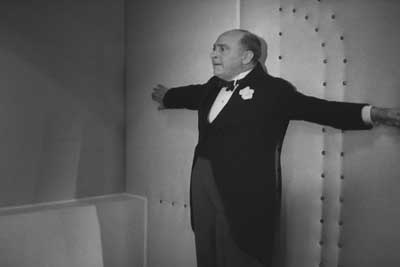
Johnson was very protective of his own Swamp Thing.
Shall We Dance is not one of Astaire & Rogers best films (props goes to Top Hat and Swing Time, sucka), but it is pretty good nonetheless. Granted, I’m almost positive a hell of a lot of people who read this website are going to shy away. Too old, they might say. Black & white? High-brow humor? Is that old-timey music I hear? These aspects are out of the many that define the film, but also add to its charm, like a time capsule unearthed alongside the Ape ruins. Don’t let them fool you, as Shall We Dance encapsulates the best of what Astaire & Rogers have to offer: a relatively painless escape through the annals of high society encircled by some splendid dance numbers and musical interludes. I’m guessing I have two people left in our reading group now.
The plot has always been a secondary characteristic in any Astaire & Rogers film. The first and foremost goal is to showcase their skills as the premiere singing and dancing duo. These uncanny skills were honed throughout their careers (Fred on the Vaudeville stage and then Broadway, Rogers on Broadway) and finely tuned for the cinematic equivalent to become a force of sheer entertainment. In this alone, Astaire & Rogers both excel at unnatural levels, as they dip, turn, flip and show an effervescent style and grace sorely lacking from the ‘musical’ pictures of today. These two masters at their craft are able to transfix your eyes while on screen, abilities that create a great aspect of star power.
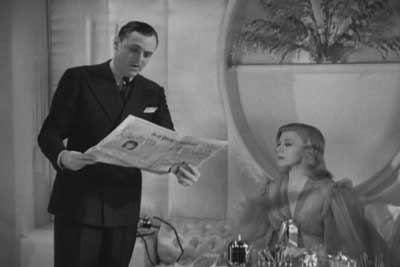
"I believe it says the Fischercats are teh sux"
Astaire’s Peter P. Peters/Petrov is fairly well aligned for the entire film. His finest moments come through the reactions of those around him, if not for his show-stopping talent on the dance floor. His singing voice is not too shabby as well, but it’s tough to deny his presence, his ultimate mastery of his own dancing style, as the be all end all of Astaire. There are countless moments where he shines bright, but I’m reminded on one in particular – where he gracefully and amazingly has a wonderfully comedic musical interlude with Rogers on Let’s Call The Whole Thing Off. Its in those tiny moments where he is sighing with his eyes and playfully teasing Rogers before going off on his skating tangent, that you come to enjoy everything he’s offered you.
Speaking of songs, the contribution of geniuses George and Ira Gershwin is so prevalent that it ranks up their as one of the best musical backings for the gruesome dancing twosome. Gershwin’s songs of They All Laughed, the Academy nominee They Can’t Take That Away From Me and Let’s Call The Whole Thing Off might be fuzzy for those fed a steady diet of music from today, but one or two minutes of these titans would most likely have a very familiar ring to it. I’m sure most people might not know of them by name, but rather by sound. It’s a testament to the Gershwin’s abilities as composers (thus showing up previous Astaire & Rogers musical guru Irving Berlin) that these songs continue to thrive today, even if it is your Grandmother humming out They Can’t Take That Away From Me while she loans you 20 bucks.

When getting a call from Christopher Lambert, it’s best to react accordingly.
As for Rogers, her Linda Keene is a firestorm of emotional response. She’s made to look like the other RKO beauty queens of the era, typical all the way down to the extravagant breakfast-in-bed scene. Rogers has the necessary qualities to keep you fixated on her specifically. It’s in her own skills as a competent singing and dancing foil to Astaire that you realize, in their seventh collaboration, that the pair were indeed made for one another. Rogers is the shining half of their creative partnership, and it’s pretty damned good to see her having fun like Astaire clearly is.
Director Mark Sandrich steers our two leads into terrific territory as two people who clearly don’t love one another into the stormy seas of a – gasp – relationship. He’s never too flashy with his direction, preferring to let things happen in the same shot. Therefore, he contains the relative action into a long shot, allowing you to focus in on the spectacle of Astaire & Rogers dancing either together or by themselves. It’s not manipulative as much as it is standard of the times. The only real instances where he goes in closer to the characters are the smaller moments where secrets are revealed and motives/emotions are presented. Other than that, his time before (on Top Hat) with the team was time well spent. It’s just that as a whole, Shall We Dance doesn’t really have the same narrative coherency (it’s a little slapdash) as previous Astaire & Rogers films, thus regulating it to the lower annals of their illustrious career.
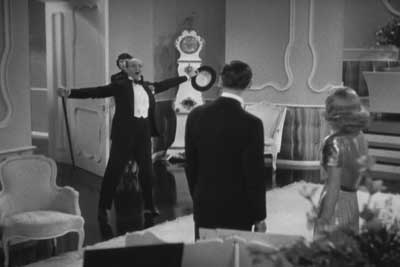
"I just got a giant BJ!"
However, if you’re willing to go alone for the journey with two insanely old movie stars, you won’t be disappointed. That is, unless you absolutely hate watching people sing and dance. As for me, those simple aspects are as entertaining today as they most likely were way back when.
8.3 out of 10
The Look

The original gangsta.
Presented in the films original aspect ratio of 1.33:1. The print is relatively cloudy at points, which is then followed up by relatively sharp contrasts and clean imagery the others. Image quality waffles back and forth considerably at the expense of very subtle shifts. They’re noticeable in some scenes (Rogers’ hotel room for starters) but only if you’re really paying attention. This could be a variety of reasons, most of all because of my abilities to be wrong time after time.
7.5 out of 10
The Noise

As Hans tightly gripped his all with full force, all Jones
could think about was Prancer.
Glorious Mono! Coming through your center channel wide and clear, with enough inflection on all sides to understand what’s being done, said and sung for all hearts content. Can’t get much better than that.
9.5 out of 10
The Goodies
You get a rather in-depth commentary track from songwriter Hugh Martin and Pianist Kevin Cole. Mr. Cole certainly loves to chat, and that’s exactly what he does with Mr. Martin, who made a name of himself with Judy Garland and the like. Since the primary career of both men has been in the music sector, it’s clear they represent a rather large aspect to bring to the Shall We Dance table. Their insight, remarks, and causal conversation between one another is incredibly informative. One thing, though, prepare to be on your toes, as both Cole and Martin embed upon you the dreaded information overload. Seriously, there are a thousand items that make up their incredible conversation between one another. I have pages and pages of information.
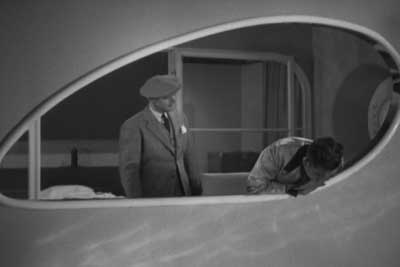
"Henry! I told you you’re not gonna find
Deep Rising in there! He’s back in the lounge!"
There’s also a new featurette: The Music of Shall We Dance (runtime – 15:41) that has a wealth of pundits discussing the various merits of the film. Kevin Cole makes another appearance (although Martin does not), where he talks at length about On Your Toes, the Broadway musical that was translated into the film. Leonard Maltin makes an obligatory appearance, and even though he absolutely loves everything, he’s a more than capable film historian whose stories are worth the price alone. The whole featurette is steeped in the various history of the film itself, and in the full 16 minutes of the short, it goes through a rather large chunk of history, culminating in the death of George Gershwin at 38 with sad twinkly piano music.
Next up is the classic cartoon: Toy Town Hall (runtime – 6:30) and it’s a little boring. This Merrie Melodies short film is all about what happens in a child’s room once the lights go down and contains a wealth of old humor that didn’t translate well for me. If I were younger, this short might be pretty fun, but as it stands, it was just toys singing and dancing. There’s not much there that’s exciting for me, other than the actual animation itself. As for that, it’s done fairly amazingly.
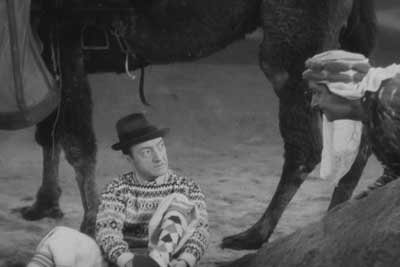
"Say, you weren’t in Carpool, were you?"
Finally, there’s a short film: Sheik-to-Sheik (runtime – 21:28), a title that’s a play on words of the infamous song from Top Hat. Starring Georges Mataxa, it nevertheless isn’t about him as much as it is centered around his golfing buddy who looks almost like an altered David Paymer and is whacked into a dreamland of the desert, courtesy of one swift golf ball to the head. He’s transported into a hazy Sheikland, complete with white soldiers and radios. Sensing his call to action, selling radios that is, he becomes embroiled in some crazy scheme setting up a radio station for the Mad Sheik in the desert, when the Sheik ups and decides to kidnap him and a local girl. The plot isn’t very deep, but it does have a few giddy moments interspersed with a joyous B-level quality that the short most likely came from. Placed together with the rest of the material, these shorts have a cohesiveness to them, almost like an entire night out watching Shall We Dance.
7.0 out of 10
The Artwork
 Most likely from an original source, most likely a theatrical onesheet. Never have I felt so entirely smart as I do now. Having Astaire & Rogers on roller-skates was a nice touch, considering their song featuring those devil things is pretty lively and loads of fun. It’s almost as if they’re beckoning you to check them out, although only the Satan should be allowed to do that. Still, the Artwork is worthy enough to illicit even the most hardened of assholes to check it out, hopefully though, if only they enjoy older musicals.
Most likely from an original source, most likely a theatrical onesheet. Never have I felt so entirely smart as I do now. Having Astaire & Rogers on roller-skates was a nice touch, considering their song featuring those devil things is pretty lively and loads of fun. It’s almost as if they’re beckoning you to check them out, although only the Satan should be allowed to do that. Still, the Artwork is worthy enough to illicit even the most hardened of assholes to check it out, hopefully though, if only they enjoy older musicals.
8.0 out of 10